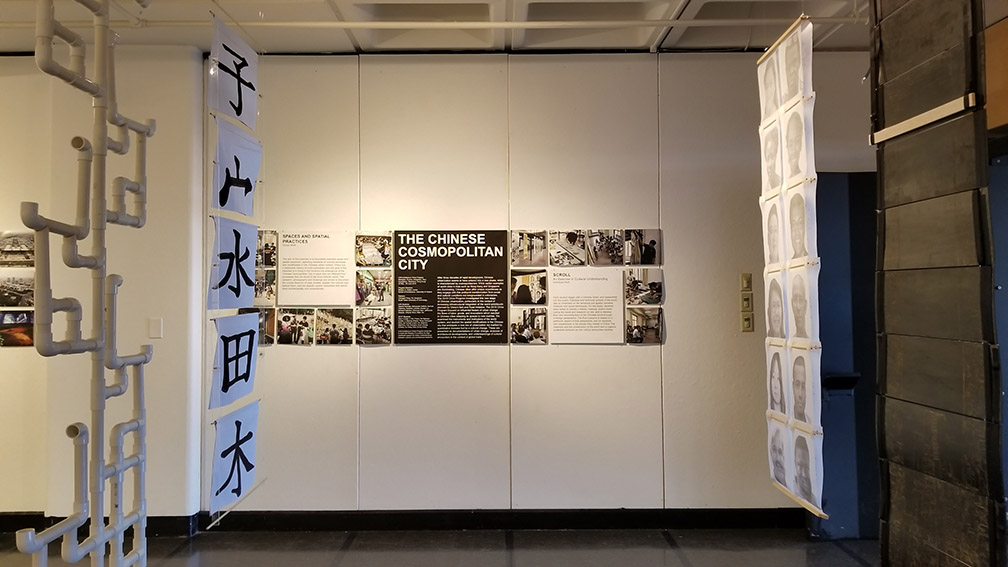









The Chinese
Cosmopolitan City
2019 UVA Architecture in China Program Exhibition
After three decades of rapid development, Chinese urbanization seems to have entered a new phase, which is characterized by cosmopolitanism. While earlier examples of world cities in Asia such as Hong Kong and Singapore are illuminating, Chinese cities offer unique experiences as they engage with this profound transformation from social and cultural conditions not foregrounded in colonialism. The 2019 China Program investigated this new stage of Chinese urbanization, particularly in the context of increasing infrastructural integration of the world ambitiously planned by China’s Belt and Road Initiative. The 2019 China Program focused on influential factors of urban change: the flows of labor, goods, and innovations which resulted in Chinese cities adapting its spaces to new realities. We examined the instruments and institutions of the world system and studied the spatial modifications in the Chinese city that anticipate a new era of urbanization not marked by quantitative increase but by a cultural change. These are presented as documentations of urban change, analyses of architectural developments, and understandings of cultural encounters in the context of global trade.
Program Directors: Shiqiao Li, Esther Lorenz
South China University of Technology partners: Changxin Peng, He Jianghuan
University of Virginia students: Gabriel Andrade, Aleksander DeMott, Samuel Feldman, Hutchins Landfair, Amelia Lin, Michael Peterson, Xiaoxuan Ren, JaRhonda Roberts, Chenan Shen, Mark Tao
South China University of Technology atudents: Zhen Li (Lily), Li Xin (Yuen), He Weixuan (Celia), Li Jiayong (Karen), Peng Chengyao (Pel), Lei Yuxuan (Layh), He Jianzhao (Marcho), Fan Zhengwu, Huan Xiaoge (Chloe), Liu Dong Yuan (Dong Dong)
2019 UVA Architecture in China Program Exhibition
After three decades of rapid development, Chinese urbanization seems to have entered a new phase, which is characterized by cosmopolitanism. While earlier examples of world cities in Asia such as Hong Kong and Singapore are illuminating, Chinese cities offer unique experiences as they engage with this profound transformation from social and cultural conditions not foregrounded in colonialism. The 2019 China Program investigated this new stage of Chinese urbanization, particularly in the context of increasing infrastructural integration of the world ambitiously planned by China’s Belt and Road Initiative. The 2019 China Program focused on influential factors of urban change: the flows of labor, goods, and innovations which resulted in Chinese cities adapting its spaces to new realities. We examined the instruments and institutions of the world system and studied the spatial modifications in the Chinese city that anticipate a new era of urbanization not marked by quantitative increase but by a cultural change. These are presented as documentations of urban change, analyses of architectural developments, and understandings of cultural encounters in the context of global trade.
Program Directors: Shiqiao Li, Esther Lorenz
South China University of Technology partners: Changxin Peng, He Jianghuan
University of Virginia students: Gabriel Andrade, Aleksander DeMott, Samuel Feldman, Hutchins Landfair, Amelia Lin, Michael Peterson, Xiaoxuan Ren, JaRhonda Roberts, Chenan Shen, Mark Tao
South China University of Technology atudents: Zhen Li (Lily), Li Xin (Yuen), He Weixuan (Celia), Li Jiayong (Karen), Peng Chengyao (Pel), Lei Yuxuan (Layh), He Jianzhao (Marcho), Fan Zhengwu, Huan Xiaoge (Chloe), Liu Dong Yuan (Dong Dong)
